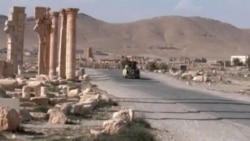Syrian government forces backed by Russian airstrikes recaptured the ancient city of Palmyra from Islamic militants Sunday. In it are the monumental ruins of a great city at the crossroads of Roman, Greek and Persian civilizations from the first to the second centuries.
The UNESCO world heritage site had been held by IS since last May. During that time, the militants looted graves, plundered antiquities, and dynamited shrines and temples in what the United Nations has called a war crime.
Despite massive destruction, photographs and field reports show that much remains intact, according to the Syrian Antiquities and Museums Directorate, which is prepared to restore the extensive damage.
"We have huge capabilities and expertise in the general directorate of antiquities and museums," said Mamoun Abdulkarim, who heads the directorate. "We have already executed tens of restorations works in Palmyra. We have the experience to accomplish this."
Abdulkarim believes the city can be rebuilt within five years.
Too ambitious, some say
Others say that is an impossible goal.
Amr Al Azm is an associate professor of Middle East History and anthropology at Shawnee State University in Ohio, who previously was the director of science and conservation laboratories at the Department of Antiquities in Syria and a professor at the University of Damascus. He says that a five-year time scale is far too ambitious.
"Really, the best that we can say right now is that some parts — like the Arch of the Triumph — may be repairable because there is more of it left, lying around close by. The Temple of Bel is going to be far more challenging," he said.
Prior to any work, the city must be secured and cleared of mines.
"It's also a city that has been depopulated. There is almost no one left there. We're still a long way away from all of this," Azm said.
UNESCO Director-General Irina Bokova said in a statement that she is "ready to send a UNESCO emergency assessment experts' mission to map the damages at the UNESCO World Heritage Site at Palmyra." The U.N. body is planning to hold a conference on the cultural heritage of Syria with a team of experts by the end of April.
Precautionary measures
Abdulkarim expects the Syrian government to take strong precautionary measures to prevent Palmyra from falling back into militant hands.
"We expected the worst because of the liberation fighting, but I think the nightmare is over. The panoramic picture of Palmyra is fine," he said of the city that Syrians refer to as the "Pearl of the Desert."
Azm says this iconic city, beloved by Syrians, could be a bridge in building peace.
"One can only be hopeful that one day this conflict will end and Syrians will find a way to reach across the divide between them and find ways to reconcile themselves with their past and move on," he said.
Abdulkarim, the antiquities chief, is calling on the international community to stand with Syria in this cultural battle.












